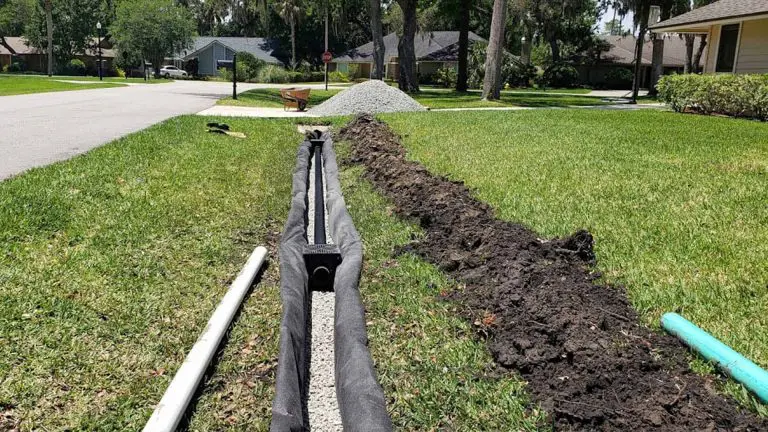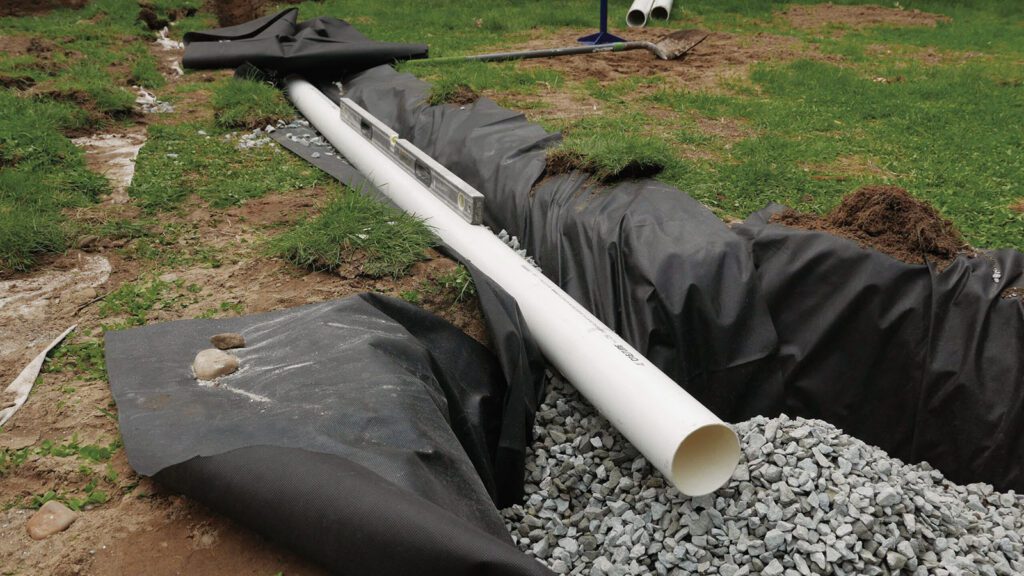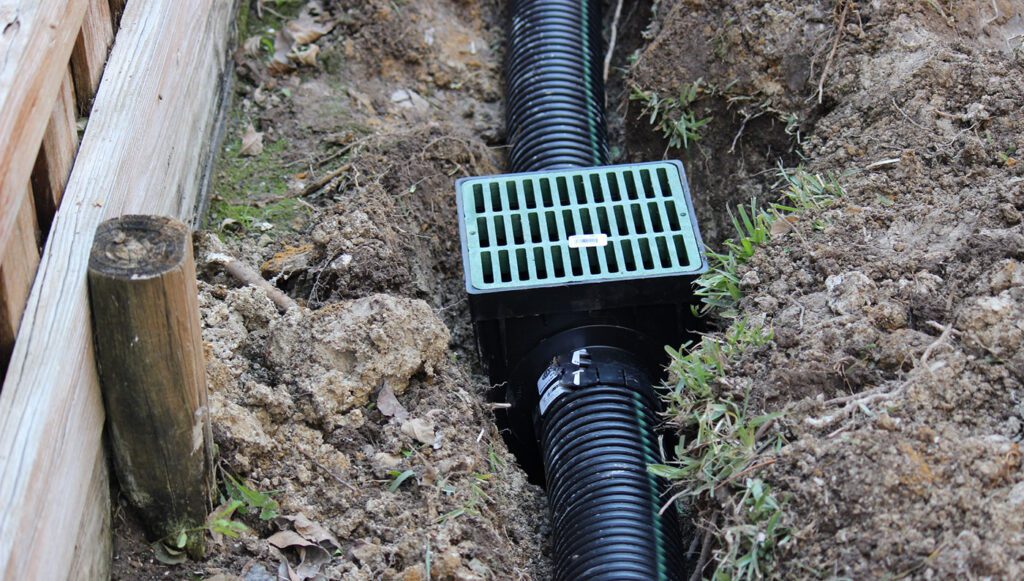How Deep for French Drain? Avoid This Common Mistake
Installing a French drain? The depth of the trench plays a key role in how well it redirects water away from your home, preventing flooding and damage.
In this guide, we’ll cover what factors determine the perfect depth for your French drain and walk you through the steps to install it effectively for optimal results.
How Deep for French Drain?
A French drain should be at least 18-24 inches deep, depending on the area’s drainage needs. For areas with more water, go deeper to ensure proper flow and prevent flooding.
Key Takeaways
- The ideal depth for a French drain typically ranges from 18 inches to 36 inches, depending on the area’s soil and drainage needs.
- A French drain must be installed at a slight slope to ensure water flows properly.
- Regular maintenance is essential to ensure the continued effectiveness of your French drain.
What Is a French Drain and Why Is Depth Important?

A French drain is a trench filled with gravel or rock and a perforated pipe that is designed to redirect excess water away from an area.
It is often used to alleviate issues like standing water, soggy yards, or basement flooding.
The drain works by allowing water to flow through the perforated pipe and into the gravel, where it is filtered and redirected to a proper drainage location.
The depth of a French drain is crucial because it determines how well the system can capture and redirect water.
A drain that is too shallow might not reach the necessary water table, while one that is too deep can be overkill, leading to unnecessary costs and complicated installation.
A French drain is a highly effective drainage system that is commonly used to manage excess water around a property.
It consists of a trench that is filled with gravel or rock and features a perforated pipe buried within the gravel.
The purpose of the French drain is to capture excess water that may otherwise collect in unwanted areas, such as in soggy yards, basements, or around a foundation, and redirect it to a more suitable drainage location.
How Does a French Drain Work?
The principle behind a French drain is relatively simple. When water accumulates in an area, it flows into the trench where the perforated pipe is placed.
The pipe allows the water to enter and flow through it, while the gravel or rock surrounding the pipe helps filter out dirt and debris.
This filtration ensures that the water is effectively redirected to a safe drainage area without clogging the pipe.
The water is then moved away from areas where it can cause damage, such as basements, lawns, or foundations.
French drains are especially beneficial for homeowners dealing with issues like standing water, basement flooding, or poor drainage around the foundation of the home.
They can be installed in both residential and commercial properties and are a relatively cost-effective solution to resolve drainage issues.
They can be customized in terms of size and shape, depending on the area needing drainage, making them versatile and adaptable to different environments.
Why Is Depth Important in a French Drain?

The depth at which a French drain is installed plays a significant role in how well the system functions.
It’s important to get the depth right in order to maximize the effectiveness of the drain, avoid unnecessary costs, and prevent complications in french drain installation.
To determine the ideal depth, it’s important to assess the water table in the area where the drain will be installed.
A professional contractor or landscaper will be able to evaluate the soil and conditions of your property to ensure the correct depth for optimal performance.
A French drain that’s too deep may also lead to a situation where water is captured and redirected to an area that doesn’t solve the original issue.
The drainage could end up moving water too far away from the source, causing other problems in different parts of the property.
Therefore, it is important to strike a balance with the depth of the drain, ensuring that the water is captured effectively without making the system over-complicated.
For example, a shallow French drain might be sufficient for a simple yard drainage problem where the soil isn’t too saturated.
In contrast, a deeper drain may be needed for areas with significant standing water or where water needs to be diverted from a foundation.
In general, the deeper the trench, the more effective the French drain will be at capturing and redirecting water, but it’s important to avoid going too deep.
How to Determine the Right Depth for Your French Drain

Several factors affect how deep your French drain should be. Here are the most important considerations when determining the depth:
1. Type of Drainage Problem
The first factor to consider is the type of drainage issue you are trying to address. For example:
Surface Water: If you’re dealing with water pooling on the surface of your yard, a French drain with a depth of about 18 to 24 inches should be sufficient.
Subsurface Water: If water is seeping through the ground and affecting your foundation or basement, you may need a deeper trench, typically between 24 to 36 inches.
2. Soil Type
The type of soil in your yard also plays a role in determining the depth of the French drain. Different soils absorb and drain water at different rates.
If you have heavy clay soil, which doesn’t drain well, you might need a deeper French drain to ensure proper water flow. In contrast, sandy soil drains water much more easily, and a shallower drain may be sufficient.
3. Slope of the Land
A French drain relies on gravity to work effectively, so it must be installed with a slight slope. The depth of the drain will be affected by the slope of your land.
For every 10 feet of length, a French drain should have a slope of about 1 inch to ensure water flows properly.
You’ll need to account for the slope when digging the trench to ensure the water can flow easily through the pipe.
4. Purpose of the Drain
Are you installing a French drain for a yard, driveway, or to protect a building foundation? The depth required will vary based on the intended purpose.
For example, a French drain around a foundation may need to be deeper than one simply redirecting water in a garden.
The depth of a French drain is a critical factor in ensuring its functionality and effectiveness.
A properly installed French drain that is the correct depth will capture and redirect water efficiently, preventing water damage, foundation problems, and flooding.
When planning your French drain system, it’s essential to strike the right balance—not too shallow and not too deep.
By assessing the local water table, soil type, and the specific drainage needs of your property, you can ensure the system will operate at its best.
Always consult with a professional contractor who can guide you through the process, ensuring that your French drain is installed with the optimal depth for maximum performance.
Standard Depths for French Drains
While the depth of your French drain depends on the factors above, there are standard guidelines for typical drainage scenarios:
1. Shallow French Drains (18–24 Inches)
For areas with surface water pooling or to redirect rainwater away from garden beds, a shallower French drain typically works best.
These drains are usually around 18 to 24 inches deep. They are often used in yards or gardens where water sits on top of the soil and doesn’t soak in deeply.
Best For: Yard drainage, garden beds, surface water pooling.
Depth Range: 18 to 24 inches.
2. Medium Depth French Drains (24–30 Inches)
For areas with moderate water issues or when a slightly deeper drain is needed to capture water below the surface, a medium-depth French drain may be used.
These drains can help reduce water seepage around foundations or prevent minor flooding in basements. They are generally installed between 24 and 30 inches deep.
Best For: Minor foundation protection, draining shallow waterlogged areas.
Depth Range: 24 to 30 inches.
Deep French Drains (30–36 Inches)
For severe drainage issues or to address subsurface water, such as groundwater or water accumulating in basements, a deeper French drain is required.
These drains are usually 30 to 36 inches deep and can effectively redirect water around a home’s foundation or other critical areas.
Best For: Foundation protection, basement drainage, severe water issues.
Depth Range: 30 to 36 inches.
How to Install a French Drain at the Right Depth

Now that you understand the factors involved in determining the right depth for your French drain, here’s a step-by-step guide to installing one:
1. Plan the Route
Start by planning the route for your French drain. Ideally, the drain should run from the area with water problems to a place where water can safely drain away, such as a storm drain, ditch, or dry well.
Use a level or a laser to make sure the route has a slight slope (about 1 inch for every 10 feet).
2. Dig the Trench
Using a shovel or trenching machine, dig the trench along the planned route. Make sure to dig deep enough to accommodate the required depth for your drain.
For a typical French drain, aim for a depth of at least 24 inches, though it can go up to 36 inches for more serious drainage issues.
The width of the trench should be around 6 inches to 12 inches, depending on the size of the perforated pipe.
3. Add Gravel to the Bottom
Place a layer of gravel at the bottom of the trench. The gravel will help filter the water before it enters the perforated pipe.
Make sure the gravel layer is about 3 to 4 inches deep, providing a good base for the pipe.
4. Install the Perforated Pipe
Place the perforated pipe on top of the gravel layer. Ensure that the holes in the pipe face down so that water can flow into the pipe from below.
This positioning helps with proper water filtration and prevents clogging.
5. Cover the Pipe with More Gravel
After placing the pipe, cover it with more gravel to ensure proper drainage. The gravel should fill the trench to just below the surface, leaving enough space for soil or a cover to be placed on top.
6. Fill the Trench
Once the gravel is in place, cover the drain with soil or sod to restore the surface.
You can also add a layer of landscape fabric over the gravel before filling the trench with soil to prevent sediment from clogging the drain.
When to Call a Professional
While installing a French drain can be a manageable DIY project, there are times when it’s best to call a professional.
If you have large amounts of water to drain, or if you’re dealing with a complicated landscape, such as heavy clay soil or difficult terrain, a professional will have the expertise and equipment needed to do the job correctly.
A professional will also ensure that the French drain is installed at the correct depth and with the proper slope to guarantee its effectiveness.
Frequently Asked Questions
1. How deep should a French drain be for a small yard?
For a small yard with surface water issues, a French drain depth of 18 to 24 inches is typically sufficient to handle drainage needs.
2. Can I install a French drain myself?
Yes, with the proper tools and knowledge, you can install a French drain yourself. However, for more complex drainage issues, it’s advisable to consult with a professional.
3. How long will a French drain last?
A properly installed French drain can last for many years, typically 20-30 years, as long as it is maintained and kept free from clogs.
Conclusion
The depth of your French drain plays a critical role in its effectiveness.
By understanding your drainage needs and choosing the right depth, you can ensure that your French drain performs optimally, helping to prevent water damage and maintain a dry, functional space.
Whether you decide to tackle the project yourself or enlist the help of a professional, following the correct installation steps will give you a long-lasting solution to your water drainage problems.
